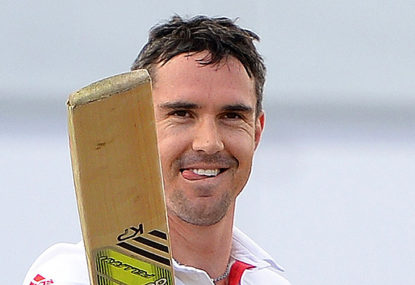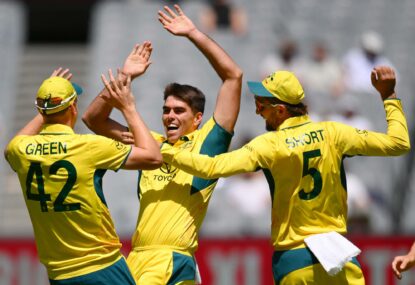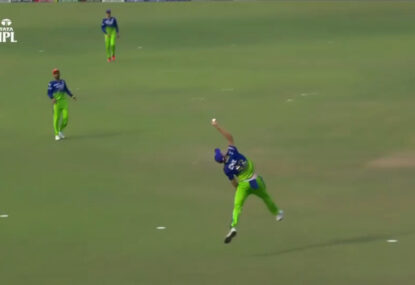If recent Ashes history is anything to go on, Kevin Pietersen will have a field day when he gets his chance to bat in tomorrow’s highly-anticipated Adelaide Test.
Day one marks the seven-year anniversary of the frantic fifth day in the widely-dubbed ‘Amazing Adelaide’ Test match, where the likes of Warne and Hussey weaved their magic against eleven spellbound Englishmen.
It was not a good day in particular for the South African-born Pietersen.
After being bowled around his legs for two before lunch by a ripping Shane Warne leg break, he later conceded four overthrows during Australia’s run chase – in a moment Ian Chappell classically described on commentary as “stupid and unnecessary”.
Unfortunately for KP, these two fails are bound to be how most Australian fans will remember, with a wry smile, his playing days at the Adelaide Oval.
But from a cricket purist’s perspective, his accomplishments at the ground far outweigh that day of miniscule mediocrity.
In three Test innings at the City of Churches, Pietersen has accumulated 387 runs at the Bradmanesque average of 129.
And despite a lacklustre 2013, I cannot help but believe that another awe-inspiring, breath-taking, show-stealing performance is on the cards – in what could be the last Test appearance he makes at his favourite Australian ground.
Standing on Australian soil for the first time as an international cricketer in the summer of 2006/07, KP remained a relatively fresh-faced member of an England side blended in both youth and experience.
Just like his new and improved ‘ferret’ look, unveiled to the world after the successful disposal of a dead skunk from his skull, Pietersen’s Test batting record had vastly improved after the discrepancies displayed in his debut series.
I say discrepancies, despite being the leading run scorer of the series with 473 at 52.55 – enough to earn a spot in Wisden’s Five Cricketers of the Year.
Cricket stats are a funny thing, hey? Now boasting five hundreds and six fifties to his name after a whirlwind year, Pietersen had his sights firmly set on dominating down under.
The Australian public already knew he was talented, but more than that, regarded him a born match-winner. How could they not since his scintillating 158 at the Oval in 2005, to fittingly conclude the greatest Ashes series of all time?
However, I do believe that the ICC should have investigated those two early missed catches – which may have been influenced by the foul odour wafting from his helmet. After all, both were dropped behind the wicket.
Irrespective of whether carrying a dead skunk constitutes fair play, there was no denying the man’s class.
15 months after his heroic Oval century, KP scored his second 158 against Australia, and the third of his young career at the Adelaide Oval.
Unlike the 2010/11 and 2013/14 campaigns, he carried into the game good form from the Gabba – where he made a dynamic 92 and was involved in a terrific 153-run fourth innings partnership with the fighting Paul Collingwood (96).
The duo doubled their efforts a week later, with Collingwood (206) and Pietersen amassing a then-record fourth wicket partnership of 310.
There were two aspects to this KP cracker that have always stood out for me.
One was the maturity he showed in gelling with Collingwood – a passive player that completely contrasted his aggressive style and temperament, but together built what should have been a match-winning partnership.
Secondly and perhaps most significantly was the way he beat Shane Warne into submission – not through senseless slogging, but by calculating construction.
He started slowly, before gaining the team a touch of momentum before stumps on day one.
Feasting on three remotely short deliveries in an otherwise tight Shane Warne spell, ESPN Cricinfo’s commentary paints a picture of his class:
“74.1 – Warne to Pietersen, FOUR, shot! That’s just brilliant from Pietersen, rocking back, standing tall and hammering Warne in front of square for four. He laced that.
“74.2 – Warne to Pietersen, FOUR, even better! A quicker ball with a touch more top-spin, Pietersen is lightning-quick on his feet and crashes it slightly finer this time, but the same result.
“84.4 – Warne to Pietersen, FOUR, ah, that’s brilliant. Only a fraction too short, Pietersen is so quick to rock back and cut him powerfully in front of square for four.”
Much of the same back-foot bashing continued the next day, but mainly against Australia’s pace men.
Warne was spared due to the defensive tactics employed by captain Ricky Ponting.
This was to bowl outside Pietersen’s legs from around the wicket, with a stacked onside field. While it did take the LBW dismissal out of the equation, it also restricted run flow on what was a lifeless pitch with a lightning outfield.
Of course this plan did not go down too well with the excitement machine in the middle, who animatedly kicked each ball away in frustration.
The paying crowd understandably became restless, but I was surprised and disappointed with the harsh criticism Ricky received from the Channel Nine commentary team – most of them former Australian captains themselves.
Whether they had been spoilt over that era by the aggressive brand of cricket that had come to be expected from an Australian XI, or were obliged to entertain a whole new legion of fans in a family-friendlier game, these legends failed to recognise the importance of Ricky’s move.
If he had continued allowing England to attack their way to a first innings total of 600, 700 and beyond, that would have almost certainly put the game out of Australia’s reach.
This was one flaw in Steve Waugh’s captaincy, who attacked his side to a series defeat in that incredible Indian tour of 2001.
So take note Michael Clarke – wicket-taking fields don’t always win you cricket matches, especially on flat tracks!
But it was no real surprise when KP eventually found a way of combatting this tactic. By opening and widening his stance, he gave himself a greater chance of finding the tight leg side gaps.
His chances improved even more when he started to dance down the wicket to good-length balls, making them half volleys.
Out of all the boundaries this earned him, one shot of sheer brilliance comes to mind. It was reminiscent of a golf swing, minus the prancing down the pitch – hands high on the handle, working together for a smooth swing and strong follow through to the shoulders.
KP’s target was the deep mid-wicket fence, through a gap between deep mid-on and short mid-wicket not much more than ten meters.
As I’m sure you can guess, he pierced it perfectly – in what Simon O’Donnell summed up as “taking one of the world’s best bowlers, and making him look skilless.”
After eventually running himself out for that cursed score of 158, and failing in the second innings, KP’s regular contributions throughout the rest of the series again earned him top dog (or skunk) status in a now-floundering English side.
He finished as the second-highest run scorer of the series behind the brilliant Ricky Ponting, with 490 runs at 54.44.
By the time England returned to Australia to once again defend the urn in 2010/11, it was clear that plenty had changed for KP.
I could see a 30-year-old in the prime of his cricket career, with a formidable record and (finally!) a half-decent haircut to show for it.
But more importantly, I saw a more mature man desperately push any media and management issues aside for the sake of his now-successful team.
While most individuals in this team grew as international players in the 20 month lead up to the Adelaide Test, Pietersen endured a lengthy form slump – remarkably not scoring a single international century during this period.
Achilles’ surgery certainly played a part, but I believe it was all in his head – especially when developing a strange weakness against left-arm spin bowling.
Unfortunately for Australia, this weakness did not include debutant Xavier Doherty – who was belted for 10 of Pietersen’s 34 boundaries in a career-best 227.
If his innings at the same venue four years earlier was one of class and guile, this was the alternative sequel of brute and belligerent force. A
lso instead of building one enormous 300-plus run partnership, KP was involved in three century stands with Cook (148), Collingwood (42) and Bell (68*).
I can only imagine the pain Australia’s bowlers felt that Test, after conceding 1/517 at the Gabba and then 5/620 in the next innings at Adelaide – ah, how times have changed!
This previous thought really rams home the importance of ‘daddy hundreds’, something Pietersen and England have lacked this year.
The term was devised by English batting coach and former opening batsman Graham Gooch, in reference to the legendary 333 he hammered against India at Lords in 1990.
His philosophy was simple: tons are great, but scores over 150 define matches and careers.
This also coincides with head coach Andy Flower’s team goal of grinding out huge first innings totals, giving fresh bowlers the chance to rip through the fatigued opposition.
We heard so much about these strategies when England won the Ashes in Australia for the first time in 24 years, to begin their rise to the summit of Test cricket.
I hope from an England standpoint that daddy didn’t die somewhere. Nor for that matter, did KP’s mojo against the Australians.
He managed a mere 90 runs for the remaining three Tests of the 2010/11 series and then in England earlier this year, hit 388 runs at 38.8.
That’s an okay return, particularly when compared to the efforts of all but one of his team mates. But if you were to take out that scratchy 113 at Old Trafford (he really was lucky early on), KP’s average in his 9 other innings suddenly drops to 30.55.
Some believe that this is indicative of KP’s best days being behind him, while other excuse it as a mere form slump. I for one, put it down to the outstanding bowling efforts seen so far in these six Tests from the likes of Harris, Siddle and Lyon.
No other cricketing venue in the world requires this sort of discipline more than the Adelaide Oval, which may hold the key to KP’s, and England’s fate in this heated Ashes series.





































































































